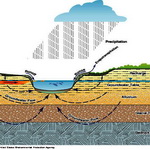Groundwater

 The best early introduction to the studies of ground water is the 1942 edition of HYDROLOGY edited by Oscar E. Meinzer with contributions to the book by 24 of the leading scientists in the field at that time. This publication included studies, definitions and all other items related to both surface and ground water and was the first collection of these items that brought the fields of surface and ground water up to date for the scientific community.
The best early introduction to the studies of ground water is the 1942 edition of HYDROLOGY edited by Oscar E. Meinzer with contributions to the book by 24 of the leading scientists in the field at that time. This publication included studies, definitions and all other items related to both surface and ground water and was the first collection of these items that brought the fields of surface and ground water up to date for the scientific community.
This study was initiated by the division of physical sciences of the National Research Council, in 1926, by the organizing of this large committee to prepare the above series of volumes on the physics of the earth, Vol. IX. “Hydrogeology, 1942, copyright, McGraw-Hill Book Company, Inc.
Chapter X, “GROUND WATER”- Pages 385 to 478, by Oscar E. Meinzer and Leland K. Wenzel is the first publication that put the entire ground water/surface water system into a reasonable combination. It includes references to publications as early as 1863, a French publication by J. Dupuit, “theoriques et pratiques sur le movement dew rauz”. The 1899 “Principles and Conditions of the Movement of Ground Water” by F. H. King was also referenced as one of the first in this field of study and was used to develop portions of the chapters in the 1942 edition. This publication brought the study of Ground Water up into the modern world of basic instramentation and mathematics and is still, today a good reference as a basic to start an analysis of a ground water system.
Over the years the field has expanded to include and use all of the advances in automatic detection of changes in ground water properties and use of computer and models to determine movement, storage changes, some water quality items, etc. The items, if desired, are recorded and/or sent to a recording collection station for storage and later use. Things can go wrong and it still takes field verifications by the hydrogeologist.
[downloads_box title=”Groundwater Subtopics:”]Ground Water Case Histories Authors of valuable case histories can emerge at any stage of practice; the goal is to identify technical and procedural problems and how they were overcome by the author.[/downloads_box]
—————————————————————————————————————————
Photo Note: The Water Cycle
© Copyright The Environmental Protection Agency.
Please join in this conversation. Use the “Comments” section below…

